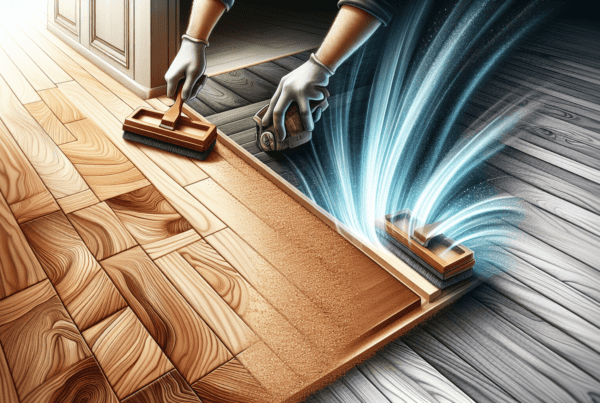Embarking on the journey of revitalizing homes, the team at Wellington Timber Floor Sanding & Finishing Specialists prides itself on bringing out the inherent beauty of timber floors. With expertise in transforming worn and faded wooden floors into stunning features of any home, we understand the importance of attention to detail and the value of using high-quality materials. Our mission is centered around not just enhancing the appearance of your floors but ensuring their longevity and durability through meticulous sanding and finishing processes. Let us help elevate the elegance of your space with our professional touch.
Overview of Timber Floor Sanding & Finishing
Definition and importance of timber floor sanding & finishing
Timber floor sanding and finishing are crucial steps in the maintenance of wooden floors. Sanding involves removing the top surfaces of a wooden floor by abrading it with sandpaper. This process evens out imperfections, removes old finishes, and prepares the floor for a new finish. Finishing, on the other hand, involves applying a protective layer that can enhance the appearance of the wood and protect it from wear, tear, and moisture. These processes are important because they help extend the life of timber floors, maintain their beauty, and ensure they remain a valuable feature of our homes.
Benefits of professional sanding and finishing services
Opting for professional sanding and finishing services brings with it several benefits. Firstly, professionals have the expertise and equipment to achieve high-quality results that are difficult to replicate with DIY approaches. They can efficiently handle various challenges, such as uneven surfaces or deep stains, ensuring the finished floor looks uniformly elegant. Furthermore, professionals can provide advice on the best type of finish for our floors, considering the wood’s characteristics and our lifestyle needs, thereby enhancing the floor’s durability and appearance.
Key differences between DIY and professional services
The main differences between DIY and professional timber floor sanding and finishing lie in the quality of the outcome, time investment, and risk of errors. Professionals possess the skills and tools to ensure a consistently high-quality finish, often completing the job more quickly and with less dust and mess than a DIY attempt. On the other hand, DIY can be more cost-effective but comes with the risk of uneven sanding, damage to the wood, and a less durable finish if not done correctly.
Understanding Timber Floor Types in Wellington
Common timber species used in Wellington homes
Wellington homes commonly feature beautiful timber floors made from species such as Rimu, Matai, Oak, and Pine. Each of these species has unique colors and grain patterns, contributing to the character and ambience of our homes.
Characteristics of different timber floors
Rimu is known for its deep red hues, while Matai is appreciated for its hardness and golden tones. Oak offers a range of colors and patterns, thanks to its widespread varieties, and Pine provides a softer option with a warm, yellow tone. The choice of timber not only affects the aesthetic but also how the floor wears over time and its maintenance needs.
How timber type influences sanding and finishing techniques
Different types of timber respond differently to sanding and finishing processes. Hardwoods like Matai require specific sanding techniques to achieve a smooth finish without damage, while softer woods like Pine might need a gentler approach. Additionally, the choice of finish can depend on the wood type; for example, oil-based finishes might better enhance the natural beauty of Rimu, whereas a water-based polyurethane could be more suitable for Oak to maintain its natural color.
Pre-Sanding Preparation
Inspection and assessment of the timber floor
Before we begin sanding, it’s necessary to thoroughly inspect and assess the floor. This step helps us identify areas that need repair, any loose boards, protruding nails, or significant unevenness that could affect the sanding process.
Necessary repairs before sanding
Identified issues like cracks, gaps, or weak boards should be repaired prior to sanding. This ensures that the sanding process can be carried out effectively and safely, and results in a more uniform and stable floor.
Cleaning procedures to ensure optimal sanding results
Cleaning the floor to remove dirt, dust, and any other debris is essential for achieving the best sanding results. This not only aids in the sanding process but also ensures that the finish adheres properly to the wood, providing a seamless and flawlessly finished surface.
The Sanding Process
Equipment used by Wellington specialists
In Wellington, specialists typically use professional-grade sanding machines, such as belt sanders, edge sanders, and orbital sanders. This equipment allows them to efficiently and evenly sand floors, reaching even the most difficult corners and edges.
Step-by-step sanding procedure
The sanding process involves several steps, starting with a coarse grit sandpaper to remove the old finish and surface imperfections. This is followed by medium grit sandpaper for further smoothing, and finally, fine grit sandpaper is used to achieve a perfectly smooth surface. Specialists meticulously work through these steps, ensuring no area is overlooked.
Dealing with challenges: uneven surfaces, nails, and stains
Uneven surfaces require careful leveling during the initial stages of sanding. Protruding nails must be countersunk to prevent damage to the sanding equipment and ensure a smooth finish. Stains might need special treatment or a darker finish to conceal them if they cannot be sanded out.
Finishing Options for Timber Floors
Types of finishes available in Wellington
Wellington homeowners can choose from a variety of finishes, including polyurethane, oil-based finishes, and water-based finishes, each offering different aesthetics and levels of protection.
Choosing the right finish for your floor: matte, satin, gloss
The choice between matte, satin, and gloss finishes depends on personal preference and the desired look. Matte finishes offer a more natural look, satin finishes have a soft sheen that highlights the wood’s grain, and gloss finishes provide a high level of shine that can make rooms appear brighter.
Benefits of eco-friendly and low-VOC finishes
Eco-friendly and low-VOC (volatile organic compounds) finishes are becoming increasingly popular in Wellington, thanks to their reduced environmental impact and lower health risks. These finishes also tend to dry faster and emit less odor, making them a great choice for our homes and the planet.
Post-Sanding Care and Maintenance
Immediate care after sanding and finishing
Immediately after sanding and finishing, it’s essential to let the floor cure for the recommended time before placing furniture or walking on it. This ensures the finish hardens fully and adheres well to the timber.
Long-term maintenance to preserve floor quality
To maintain the quality and appearance of our timber floors, regular cleaning with products suitable for the type of finish is crucial. Additionally, placing rugs in high-traffic areas and using furniture protectors can prevent scratches and wear.
How to deal with scratches and wear over time
Minor scratches and wear can often be addressed with spot treatments or a fresh top coat of finish. For more significant damage, a professional re-sanding and finishing service might be necessary to restore the floor’s beauty.
Wellington Timber Floor Sanding & Finishing Specialists
Criteria for selecting a specialist
When choosing a specialist in Wellington, we consider their experience, customer reviews, the quality of their past work, and their ability to provide advice tailored to our specific flooring type and needs.
Recommended Wellington-based specialists
There are several highly recommended specialists in Wellington known for their expertise in timber floor sanding and finishing. These professionals are valued for their attention to detail, quality of work, and customer service.
What to expect in terms of cost and time frame
The cost and time frame for sanding and finishing timber floors in Wellington can vary depending on the floor’s size, condition, and the type of finish desired. Generally, we can expect the process to take several days, with the cost reflecting the scope of work and level of expertise of the specialists.
DIY vs Professional Floor Sanding and Finishing
Comparative cost analysis
While DIY sanding and finishing might seem cost-effective upfront, the potential for mistakes and the need for specialized equipment can add unexpected expenses. Professionals, with their expertise and efficiency, often provide better value in the long run.
Assessing the quality of outcomes
Professional services typically guarantee a high-quality finish, thanks to their skills and experience. DIY projects carry the risk of uneven sanding, visible marks, or incorrect application of finishes, which can detract from the floor’s appearance and durability.
Understanding the risks and rewards of DIY practices
DIY sanding and finishing can be rewarding, offering personal satisfaction and potentially saving on costs. However, it’s important to realistically assess our skills and the risks involved to ensure that the outcomes meet our expectations and do not compromise the floor’s condition.
Environmental Considerations
Sustainable sanding and finishing practices
Sustainable practices include using eco-friendly finishes, employing dustless sanding equipment to minimize airborne particles, and responsibly sourcing timber. These practices help reduce the environmental impact of sanding and finishing projects.
The impact of timber floor maintenance on the environment
Regular maintenance, when done responsibly, can extend the life of timber floors, reducing the need for replacement and the demand for new timber. This, in turn, can have a positive impact on the environment by conserving resources.
Selecting environmentally friendly materials and specialists
Choosing materials with low environmental impact and specialists who prioritize sustainable practices is key to ensuring our floor maintenance projects are as environmentally friendly as possible.
Customer Reviews and Testimonials
Insights from Wellington homeowners
Customer reviews often highlight the transformation of their homes following professional sanding and finishing, noting improvements in the appearance, feel, and value of their timber floors.
Impact of sanding and finishing on home value
An expertly sanded and finished timber floor can significantly enhance a home’s appeal, making it more attractive to potential buyers or simply increasing the owner’s enjoyment of their space.
Personal experiences with Wellington specialists
Homeowners in Wellington have shared positive experiences with local specialists, praising their professionalism, craftsmanship, and the stunning results achieved on their timber floors, further emphasizing the value of choosing the right expert for the job.







